
ENGINES AND ENGINE COMPONENTS
| 3A1. Introduction.All of the present fleet type submarines are equipped with engines manufactured either by the Cleveland Diesel Engine Division, General Motors Corporation, Cleveland, Ohio, or by Fairbanks, Morse and Company, Beloit, Wisconsin. These engines have been in the process of development for the past several years, and the latest models proved highly dependable under wartime operating conditions.
Before World War II, these engines were used almost exclusively on submarines. With the expansion of the Navy, however, these engines have also been used on destroyer escorts, amphibious craft, escort type patrol vessels, and various auxiliary craft. The following sections are devoted to the discussion of basic diesel engine construction and the application of these basic principles to the General Motors and Fairbanks-Morse engines. 3A2. General Motors engines.Two models of GM main engines are found in fleet type submarines today, Model 16-248 and Model 16-278A. The former was installed exclusively in General Motors engine equipped vessels until early in 1943 when Model 16-278A was introduced. All General Motors installations since that time have been Model 16-278A engines (Figures 1-10 and 1-11). Basically the two models are similar. The principal differences are in the size and design of the parts, methods of construction, and type of metals used. In the following chapters all references are based on the current Model 16-278A. Important differences between the two models, however, will be noted. The GM engine is a 16-cylinder V-type engine with 2 banks of 8 cylinders each The engine operates on the 2-stroke cycle principle, is air started, and is rated at 1600 bhp at 750 rpm. The size of the bore and stroke of the 16-248 engine is 8 1/2 inches and 10 1/2 inches respectively as compared to 8 3/4 inches and 10 1/2 inches for Model 16-278A. The General Motors Corporation also |
supplies a Model 8-268 auxiliary engine for fleet type submarines. This is an 8-cylinder, in-line, 2-cycle, air starting engine, rated at 300 kw generator output at 1200 rpm. The size of the bore and stroke is 6 3/8 inches and 7 inches respectively.
The tables at the end of this chapter, pages 78 and 79, contain engine data, ratings, and clearances for General Motors main engines and auxiliaries. 3A3. Fairbanks-Morse engines.There are two types of F-M main engines in use in modern submarines (Figures 1-12 and 1-13). The model number for each is 38D 8 1/8. The basic difference between them is the number of cylinders, one being a 9-cylinder and the other a 10-cylinder engine. Both engines have the same bore and stroke and in most respects are similar in principle, design, and operation. The F-M 38D 8 1/8 model is an opposed piston, in-line, 2-cycle, 9- or 10-cylinder engine employing air starting and rated at 1600 bhp at 720 rpm. Bore and stroke are 8 1/8 and 10 inches respectively. An auxiliary engine, Model 38E 5 1/4, is also supplied by Fairbanks, Morse and Company. This is a 7-cylinder, opposed piston, 2 cycle, air starting engine rated at 300 kw generator output at 1200 rpm. The bore is 5 1/4 inches and the stroke 7 1/4 inches. The tables at the end of this chapter, page 80, contain engine data, ratings and clearances for Fairbanks-Morse main engines and auxiliaries. 3A4. Classification of engine components. To simplify the study of the design, construction, and operation of the component parts of the diesel engines in the following sections of this chapter, the parts have been classified under three subjects as follows: 1) main stationary parts, 2) main moving parts, and 3) valves and valve actuating gear. Section 3B deals with engine components as listed above, in general. Sections 3C and 3D deal with the same components as applied to the GM and F-M engines respectively. In all |
|
| 34 |
||
| instances the ends of the engines will be referred to as the blower and the control ends. It should be noted that the blower end of the | F-M engines is also the generator coupling end, whereas the blower end of the GM engines is opposite the generator coupling end. | |
| B. GENERAL DESCRIPTION OF ENGINE COMPONENTS | ||
| 3B1. Main stationary parts.a. Frame. The framework of the diesel engine is the load carrying part of the machinery. The design of diesel engine frames has undergone numerous changes in recent years. Some of the earlier types of framework which were eventually abandoned were: 1) A-frame type, 2) crankcase type, 3) trestle type, 4) stay-bolt or tie rod type.
The framework used in most modern engines is usually a combination of these types and is commonly designated as a welded steel frame. A frame of this type possesses the advantages of combining greatest possible strength, lightest possible weight, and greatest stress resisting qualities. The welded steel type of construction is made possible by the use of recent developments in superior quality steel. For diesel engine frame construction, steel is generally used in thick rolled plates which have good welding quality. In this type of construction, deckplates are generally fashioned to house and hold the cylinders, and the uprights and other members are welded, with the deckplates, into one rigid unit. b. Oil drain pan. The oil drain pan is attached to the bottom of the cylinder block and serves to collect and drain oil from the lubricated moving parts of the engine. The bottom of the oil pan is provided with a drain hole at each end through which oil runs to the sump tank. In some installations the bottom of the pan slopes toward one end or the other of the engine. Oil drain pans require little maintenance. They should be cleaned and flushed of any residual dirt during major overhaul periods. New gaskets should be installed at these times to assure an oiltight seal. c. Access doors and inspection covers. The cylinder block walls are equipped with access doors or handhole covers. With the doors or covers removed, the openings furnish access to cylinder liners, main and connecting rod bearings, injector control shafts, and various |
other parts for inspection and repair. The doors are usually secured with handwheel or nut operated clamps and are fitted with gaskets to keep dirt and foreign material out of the interior. Some of these access doors or inspection covers may be constructed to serve as safety covers. A safety cover is equipped with a spring-loaded pressure plate. The spring maintains a pressure which keeps the cover sealed under normal operating conditions. An explosion or extreme pressure within the crankcase overcomes the spring tension and the safety cover acts as an escape vent, thus reducing crankcase pressure.
d. Cylinder and cylinder liners. The cylinder is the enclosed space in which the mixture of air and fuel is burned. A cylinder may be constructed of a varying number of parts among which the essentials are the cylinder jacket, the cylinder liner, and in most cases the cylinder head. In most designs the space between the cylinder jacket and the liner is cored to carry circulating water for cooling purposes. There are two general types of cylinder liners. One, the wet type, is a replaceable liner that makes direct contact with the cooling water; the other, the dry type, is a replaceable liner that fits into a water-cooled jacket without making direct contact with cooling water. All submarine diesel engines under consideration here use the wet type cylinder liners. e. Cylinder head. The cylinder head seals the end of the cylinder and usually carries the valves. Heads must be strong enough to withstand the maximum pressures developed in the cylinders. Also, the joint between the cylinder and the head must be gastight. Due to the high temperatures encountered, cylinder heads must be water cooled. To accomplish this, water passages are cored in the head during the casting process. Valves usually found in the head are the exhaust valves, injection valves, and air starting valves. 3B2. Main moving parts.a. General. The main moving parts of a diesel engine are those |
|
| 35 |
||
| that convert the power developed in the cylinders by combustion to mechanical energy, that is delivered to the shaft. These parts are used to change the reciprocating motion of the pistons in the cylinders to rotary motion at the engine final drive, and may be divided into three major groups:
1. Those parts having rotary motion, such as crankshafts and camshafts. 2. Those parts having reciprocating motion, as, for example, the pistons and piston rings. 3. Those parts having both reciprocating and rotary motion, such as the connecting rods. b. Crankshaft. The crankshaft transforms the reciprocating motion of the pistons into rotary motion of the output shaft. It is one of the largest and most important moving parts of a diesel engine. The materials used in the construction of crankshafts vary greatly, depending on the size of the shaft, speed of the engine, horsepower of engine, and number of main bearings. Regardless of materials used, crankshafts are always heat treated. This is necessary in order to give uniform grain structure, which increases ductility and capacity for resisting shock. The tensile strength of crankshaft materials varies from 60,000 psi to as much as 100,000 psi. Crankshafts may be either forged or cast. They may be either made up in one section, or in two or more with the sections interchangeable for economy in construction and replacement. Crankshafts are machined to very close limits with a high finish and are balanced both statically and dynamically. The crankshaft consists essentially of a number of cranks placed at equal angular intervals around the axis of the shaft. Between the cranks are the crankshaft supports commonly referred to as the journals. Each crank on a crankshaft is made up of the crankpin, which is the journal for the connecting rod bearing, and two crank webs (Figure 3-1). Journals, crankpins, and webs are drilled for the passage of lubricating oil (Figure 3-2). All such holes are usually straight to facilitate construction and cleaning of the passages. In larger engines, crankshafts are practically always constructed with hollow main bearing journals and crankpins. This construction is |
 Figure 3-1. Nomenclature of crankshaft parts.
|
|
| 36 |
||
| much lighter than a solid shaft and is better adapted for carrying the lubricating oil to various bearings in the engine. In large engines, the crankshaft is sometimes built up by pressing the journals into the webs. In this type, generally, the crankpin and its two adjacent webs are forged or cast in one piece, this unit then being joined to other cranks by hydraulically pressing them onto the main bearing journals. The cranks are held at the proper angles during this process, after which the assembled shaft is put in a lathe and finished to size.
c. Main bearings. The function of the main bearings is to provide supports in which the crankshaft main bearing journals may revolve. In the diesel engines under discussion, modern bimetal or trimetal, split sleeve, precision type main bearings are used exclusively. Bimetal bearings consist of a thin inner layer of soft low-friction metal encased in a shell of harder metal fitted to the bearing support or bearing cap. Trimetal bearings have an intermediate layer of bronze between the shell and soft metal layers. Both types are split sleeve, divided horizontally through the center, for installation. Precision type manufacture requires that the bearing housing be precision bored to a close tolerance and that the bearing halves, when tightly drawn together, align perfectly and fit the bearing journals with a predetermined clearance. The purpose of this clearance is to provide for a thin film of lubricating oil which is forced under pressure between the journals and bearing surfaces. Under proper operating conditions this oil film entirely surrounds the journals at all engine load pressures. All main bearings contain oil inlet holes and oil grooves which permit the oil to enter and be evenly distributed throughout the inside of the bearing. These oil inlets and grooves are invariably in the low oil pressure area of the bearing. Proper bearing lubrication depends upon accurate bearing clearances as well as the type of lubrication. Too little clearance will cause the bearing to run hot and wipe out under continued operation. At high operating speeds with too little clearance, the load pressure on the bearing does not leave sufficient room for the |
lubricant to prevent a metal-to-metal contact between the journal and bearing surfaces. Excessive clearance permits the free flow of the fluid oil to the edges of the bearing. This reduces the pressure developed and consequently may overload the bearing. The stress of overload will cause the bearing to wipe and eventually burn out. Both bearing clearances and the amount of wear may be checked by measuring the thickness of the soft metal lining of the bearing shell either with a ball point micrometer or by the use of appropriate feeler gages.
Proper seating of the bearing shells and proper clearances of precision type bearing shells require that the bearing caps be drawn to the proper tightness. This is done with a torque wrench by means of which the proper torque limits in foot-pounds are obtained. As this torque varies with engine models, the current instructions should be consulted. d. Pistons. The function of a piston is to form a freely movable, gastight closure in |
|
| 37 |
||
| the cylinder for the combustion chamber. When combustion occurs, the piston transmits the reciprocal motion or power created to the connecting rod. Pistons for all the modern submarine 2-stroke cycle diesel engines are of the trunk type. Pistons of the trunk type have sufficient length to give adequate bearing surface against the side thrust of the connecting rod. Trunk type pistons have a slight amount of taper at the crown end of the piston to provide for the greater expansion of the metal at the combustion end where temperatures as high as 3000 degrees F may be encountered. This taper is sufficient so that at normal operating temperatures the piston assumes the same diameter throughout its entire length.
The piston crowns on both the GM and F-M engines are concave. The purpose of this shape is to assist in air turbulence which mixes fuel with air during the last phase of the compression stroke. Pistons are usually constructed of either a cast iron or aluminum alloy. They must be designed to withstand the gas pressure developed in the combustion chamber during the compression and expansion strokes. They must also be light enough to keep the inertia loads on the piston pins and main cranks to a minimum. e. Piston rings. Piston rings have the following three primary functions: 1. To seal compression in the combustion chamber. 2. To transfer heat from the piston to the cylinder wall. 3. To distribute and control lubricating oil on the cylinder wall. In general, piston rings are of two types. One, the compression type ring, serves primarily to seal the cylinder against compression loss; the other, the oil type ring, distributes oil on the cylinder walls and controls cylinder wall lubrication by collecting and draining excess oil. Piston rings are generally constructed of cast iron. On the average diesel piston there are four to five compression rings and two or three oil control rings. f. Piston pins. Each piston is connected to the connecting rod by a piston pin or wrist pin. This connection is through bored holes in the piston pin hubs at the center of the piston |
and the integral hub of the connecting rod. The piston pin must be strong enough to transmit power developed by the piston to the crankshaft through the connecting rod. Piston pins are usually hollow and are made of special alloy steels, case hardened and ground to size. The connection between the piston and the piston pin is either by means of needle type roller bearings or by plain bushings. The ends of the pins must not protrude beyond the surface of the piston, and their edges must be rounded to facilitate entry of the piston into the cylinder. This is usually accomplished by means of piston pin caps.
g. Connecting rods. Just as its name implies, the connecting rod connects the piston with the crankshaft. It performs the work of converting the reciprocating, or back-and-forth, motion of the piston into the rotary, or circular, motion of the crankshaft. The usual type of connecting rod is an I-beam alloy steel forging, one end of which has a closed hub and the other end an integral bolted cap. The cap is accurately located by means of dowel pins. Through the closed hub, the connection is made between the piston and the connecting rod by means of the piston pin. At the other end, the connecting rod bearing connection is made between the connecting rod and the crankshaft. The shaft of the connecting rod is drilled from the connecting rod bearing seat to the piston pin bushing seat. Through this passage, lubricating oil is forced from the connecting rod bearing to the piston pin bearing for lubrication and piston cooling. h. Connecting rod bearings. The purpose of these bearings is to form a low-friction, well-lubricated surface between the connecting rod and the crankshaft in which the crankpin journals can revolve freely. The bearings used are generally of the same material and type as the main bearings. Connecting rod bearings consist of two halves or bearing shells. The backs of these shells are bronze or steel, accurately machined to fit into a precision machined bearing seat in the connecting rod. The shells are lined with a layer of soft metal of uniform thickness. When the bearing caps are drawn tight on the connecting rod, the contact faces of the bearing shells form an oiltight joint. Also, because of the precision manufacture of all parts, |
|
| 38 |
||
| the bearing shells give the proper clearance between the bearing shells and the crankpin journals. The connecting rod bearings are pressure lubricated by oil forced through oil passages from the main bearings to the crankpin journals. The oil is evenly distributed over the bearing surfaces by oil grooves in the shells.
3B3. Valves and valve actuating gear.a. General. Control of the flow of fuel, inlet air, starting air, and exhaust gases in a diesel cylinder is accomplished by means of various types of valves. The timing and operation of these valves, for the various processes in relation to piston travel and correct firing sequence, are the main functions of the valve actuating gear. Since certain phases of timing, such as the geometrical angle of the crankshaft cranks and the geometrical angle of the camshaft cams, are fixed, timing adjustments are made through the valve actuating gear. Hence, timing adjustments must be made with extreme accuracy and the valve actuating gear must function perfectly for efficient engine operation. b. Camshafts. The purpose of the camshafts in submarine diesel engines is to actuate exhaust valves, fuel injectors, fuel injection pumps, and air starting valves according to the proper timing sequence of that particular engine. In order to perform these functions at the various cylinders in relation to their proper firing order, the camshafts are timed or synchronized |
with the operation of the crankshaft through the camshaft drive. In addition to actuating valves, camshafts, on some engines, are also used for driving auxiliaries such as governors and tachometers.
Camshafts are usually constructed in one or two parts. The number of cams on a camshaft is determined by the type and cycle of engine. The cams and camshafts are usually forged integral and ground to a master camshaft. c. Valves. The important valves found on typical diesel cylinders and their functions are: 1. Exhaust valves. Exhaust valves are used to allow the exhaust gases of combustion to escape from the cylinders. They are subject to extremely high temperatures and are therefore made of special heat-resistant alloys. In some large engines, the exhaust valves are water cooled. 2. Inlet valves. Inlet valves are used to govern the entrance of air in the cylinder of a 4-stroke cycle engine. Inlet valves are not used |
|
| 39 |
||
| in modern submarine diesel engines, having been replaced by inlet ports.
3. Fuel injection valves. Fuel injection valves are used to inject the fuel spray into the cylinder at the proper time with the correct degree of atomization. In addition, some injection valves also measure the amount of fuel injected. 4. Air starting valves. Air starting valves are used to control the flow of starting air during air starting of an engine. These valves are normally of two types, air starting check valves and air starting distributor valves. 5. Cylinder test valves. Each cylinder is provided with a test valve which is used to vent the cylinder before starting. This valve is also used to relieve the cylinder of compression when turning over the engine by hand. The same valve is used far taking compression and firing |
pressure readings of the cylinder while the engine is in operation.
6. Cylinder relief valves. A cylinder relief, or safety, valve is located on each cylinder of all submarine type engines. The function of this valve is to open and relieve the cylinder when pressure inside the cylinder becomes excessive. These valves are adjustable to be set at varying pressures according to the particular installation. When pressure drops below the setting at which the valve opens, the valve closes automatically. d. Valve actuating gear. Motion of the cams on the camshaft is transmitted to valves, injectors, and injector pumps by means of rocker arms or tappet assemblies. The rocker arms and tappets normally are spring loaded and make contact with the cams by means of cam rollers. Adjustments of the various springs and rods are very important, as they are normally the means by which the engine is correctly timed. |
|
| C. GENERAL MOTORS ENGINE COMPONENTS | ||
| 3C1. General.Descriptions of engine components in this section apply only to the General Motors engine.
3C2. Main stationary parts.a. Cylinder block. The cylinder block of the GM engine (Figure 3-8) is fabricated from forgings and steel plates welded together to form a single unit. The assembly is designed with two cylinder banks, the axes of which are 40 degrees apart, forming the V-type design of the engine. The unit is fabricated from main structural pieces called transverse frame members, upper and lower deckplates for each bank, and cross braces all welded into one rigid compact unit. The upper and lower deckplates are bored to accommodate the cylinder liners. The space between these deckplates, as well as the space between the two banks of cylinders, serves as a scavenging air chamber. The forged transverse members in the bottom of the cylinder block form the mounting pads for the lower main bearing seats. The camshaft bearing lower seats are an integral part of the cylinder block. These bearing seats and their caps are match-marked and must be kept together. Removable handhole covers close the |
openings in the sides of the cylinder block. Access to the injector control shaft is obtained by removing the top row of small handhole covers. The middle row of handhole covers permits access to the scavenging air box for inspection of the cylinder liners and piston rings. The bottom row of handhole covers permits access to the crankshaft, connecting rod, and bearings.
b. Engine oil pan. The engine oil pan is bolted to the bottom of the cylinder block. The bottom of the oil pan is provided with a drain hole at each end. One end of the oil pan is fastened to the camshaft gear train housing and the other end is fastened to the blower bottom housing. The lubricating oil from these units drains into the oil pan. The pan is constructed of welded steel in the 16-278A and of an aluminum alloy casting in the 16-248. c. Cylinder liner. The cylinder liner (Figure 3-11) is made of cast iron with a cored or hollow space in the wall through which cooling water is circulated. Water enters through a synthetic rubber gasket sealed connection near the bottom of the cylinder and circulates out through similarly sealed steel ferrules into the cylinder head. The cylinder liner is held in the engine block by the lower deckplate and a |
|
| 40 |
||
| Figure 3-6. LONGITUDINAL CUTAWAY OF GM 16-278A ENGINE. | ||
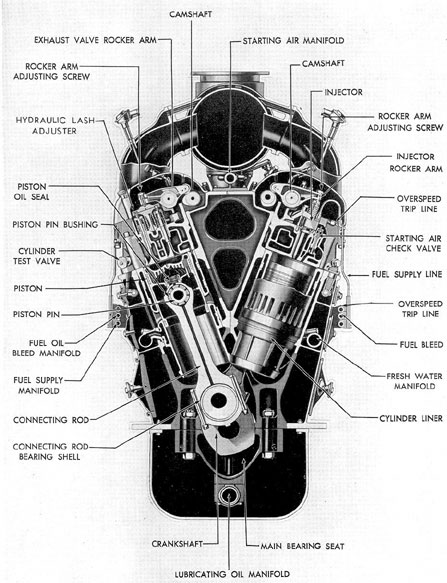 Figure 3-7. Cross section of GM 16-278A engine. |
| 41 |
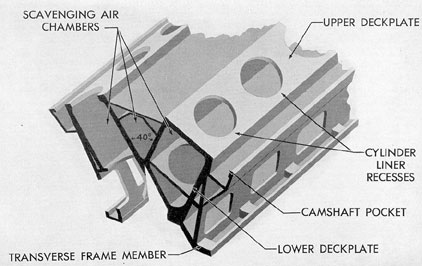 Figure 3-8. Section of cylinder block, GM. |
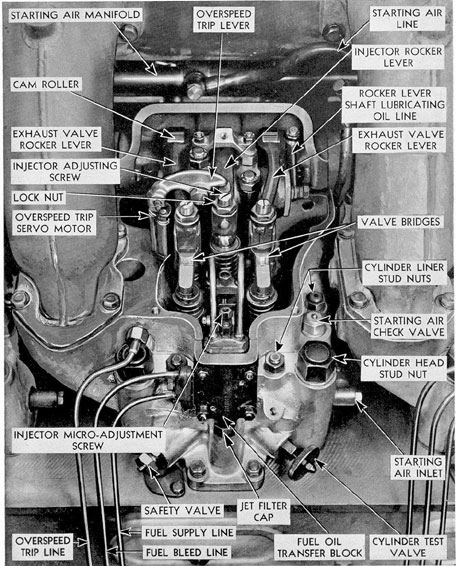 Figure 3-12. Cylinder head, GM. |
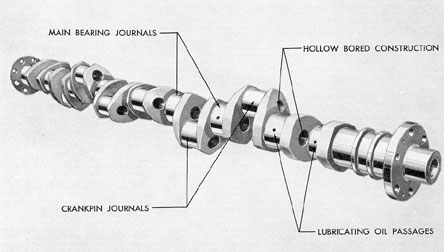 Figure 3-15. Crankshaft for GM engine. |
| fits on a dowel pin in the cap. The dowel pin locates the upper shell in the bearing cap and prevents both the upper and lower shells from rotating.
Bearing caps are held down on the bearings by jack screws locked with cotter pins. The jack screw fits into a recess in the arch of the crankcase frame and takes the upward thrust on the bearing cap. Close fit between shoulders on the crankcase frame prevents side play in the bearing cap. End play is controlled by two dowel pins. When the bearing supports and caps are assembled on the crankcase frames, the seats for the bearing shells are accurately bored in dine, and the ends of its faces are finished for a close fit between the bearing shell flanges. Each bearing shell is marked on the edge of one flange. For example, the designation 2-L-B.E. indicates that the shell is for the No. 2 main bearing, that it is the lower shell, and that the flange of the shell thus marked should be placed toward the blower end of the engine. The main bearing nearest the blower end of the engine is the No. 1 main bearing. The rear main bearing |
(No. 9) is the thrust bearing. Thrust bearing shells are the same as the other main bearing shells except that the bearing metal is extended to cover the flanges. With the exception of the thrust bearing, all upper bearing shells are alike and interchangeable before they are assembled and marked This is also true of the lower bearing shells. Upper and lower shells, however, are not interchangeable with each other.
Each lower bearing shell has an oil groove starting at the joint face and extending only partially toward the center of the bearing surface. The upper bearing shells are similarly grooved except that the groove is complete from joint face to joint face. The main bearings are lubricated by oil under pressure received from the oil manifold under the bearing supports. The oil is forced up through a passage in the bearing support and through holes drilled in the lower bearing shell. From these holes, oil flows the entire length of the oil groove formed by the combined upper and lower shells. The oil lubricates the entire bearing surface and is carried off through the |
|
| 46 |
||
| drilled passages in the crankshaft to the connecting rod bearings.
c. Pistons and piston rings. The pistons for GM engines are made of cast iron alloy which is tin plated. Each piston is fitted with five compression rings at the upper, or crown, end and two oil control rings at the bottom, or skirt, end. In latest installations, the oil control rings are of the split type backed by expanders. All piston rings are made of cast iron. The bored holes in the piston pin hubs are fitted with hard bronze bushings which are cold shrunk in the piston bores. The outer ends of the bore for the piston pin are sealed with cast iron caps to prevent injury to the walls of the cylinder from floating piston pins. The bores in the piston pin bushing are accurately ground in line for the close, but floating, piston pin fit. Each bushing has a number |
of small oil grooves cut lengthwise in the bore and these receive lubricating oil that splashes from the sprayed head and side wall surfaces.
A cooling oil chamber is formed by an integral baffle under the piston crown. Lubricating oil under pressure flows from the top of the connecting rod, through a sealing member, and into the cooling chamber. The oil seal is a spring loaded shoe which rides on the cylindrical top of the connecting rod. The heated oil overflows through two drain passages. d. Piston pins. The piston pin used on the GM engine is full floating, hollow bored, and case hardened on the bearing surface. The connection between connecting rod and the piston is by means of the connecting rod piston pin bushing. This bushing rotates freely inside the integral end of the connecting rod, and the connection is completed by pushing the piston |
|
 Figure 3-16. Main bearing cap installed, GM. |
| 47 |
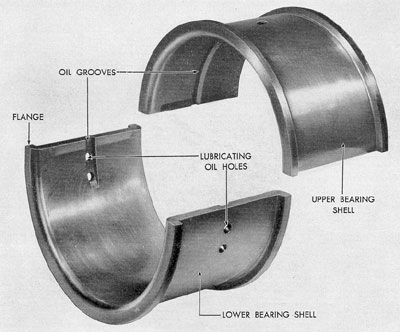 Figure 3-17. Main bearing shells. GM. |
 Figure 3-20. Cross section of piston showing cooling and lubrication, GM. |
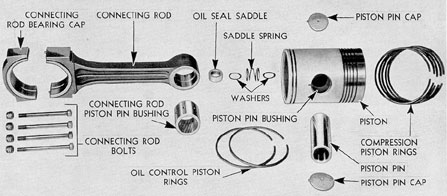 Figure 3-21. Piston and connecting rod disassembled, GM. |
| 50 |
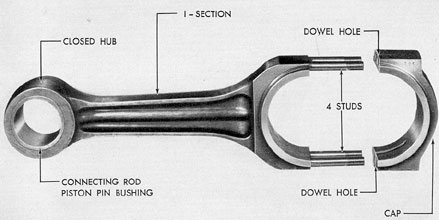 Figure 3-22. Connecting rod, GM 16-248. |
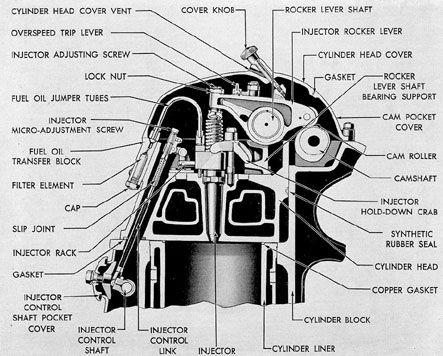 Figure 3-26. Cross section of cylinder head through injector, GM. |
| through oil pressure tubes leading from the camshaft bearings, through the endplate, and to the hollow bore in the rocker lever shaft. The oil is forced through holes in the rocker lever shaft to the rocker lever hub bearings. From the hub bearings, it is conducted through drilled passages and holes to the bearings of the cam rollers and the tappet mechanism on the injector rocker lever.
c. Exhaust valves and valve bridges. Each cylinder contains four exhaust valves. The valves are operated in pairs by the rocker levers through the valve bridges. The exhaust valves are made of special analysis, heat-resisting, alloy steel. They are held in operating position by cast iron valve stem guides. Valve springs secured to the ends of the valve stems by locks draw the valve |
heads tight on the valve seats of the cylinder head.
The valve bridges are made of forged steel and have a hardened ball socket into which fits the ball end of the adjusting screw on the rocker lever. The valve bridge has two arms, each of which extends over an exhaust valve stem. Each arm is fitted with an adjusting screw at the valve stem to equalize valve clearance. The lower part of the valve bridge is ground for a sliding fit in the valve bridge guide. This guide has a ball and socket bearing in the top of the cylinder head. The valve bridge spring keeps valve bridge tension off the valve stems until the bridge is actuated by the rocker lever. When the valve end of the rocker lever is pressed down by the cam action, the valve |
|
| 53 |
||
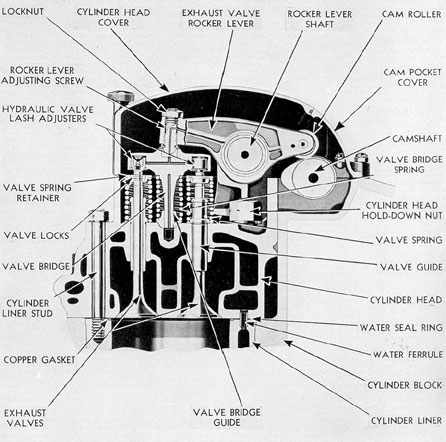 Figure 3-27. Cross section of cylinder head through exhaust valves, GM. |
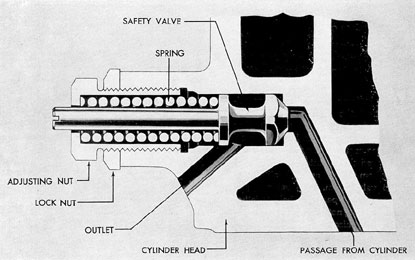 Figure 3-29. Cylinder relief or safety valve, GM. |
| The split crankshaft gear is mounted loose on the crankshaft and held together with clamping bolts. The bore of the crankshaft gear is babbitted and a circumferential groove in the bearing forms the thrust surfaces which bear against a collar on the crankshaft. The crankshaft gear is driven through a spline ring on the elastic coupling.
Each of the two idler gears and the lubricating oil pump drive gear are mounted on a heat-treated steel shaft, which is pressed into the gear hub. The two idler gear shafts are supported in inner and outer bearing supports fitted with single-flanged steel bushings, which are lined with babbitt. The bearing supports are accurately aligned with dowel pins and fastened together with studs. The pump drive gear is supported in the bearing supports of the mating camshaft gear. The hub projections on the outside of the camshaft gears are finished to form journals, and are supported in babbitt-lined steel bushings which are pressed in the inner and outer bearing supports. The inner and outer bearing supports are accurately aligned with dowel pins and are fastened together with studs. The gear |
and bearing support assemblies are located accurately in the camshaft drive housing with dowels and fastened with studs.
The outer flange of each camshaft driving sleeve is fastened to the outer face of the camshaft gear hub by capscrews. The inner end of the driving sleeve is flanged and doweled to the flanged end of the camshaft. The camshaft is driven through the dowel pins in the connection, and a bolt, smaller than the dowel pins, prevents incorrect assembling of this drive connection. The holes in the outer flange of the driving sleeve are slotted, so that the camshaft may be accurately adjusted to the correct timing position. When this adjustment has been made, the timing position is permanently fixed by dowel pins, through which the driving sleeve and the camshaft are driven. Oil for lubricating the gear teeth and the gear bearings is received from two oil-distributing blocks in the camshaft drive housing. The two distributing blocks are supplied with oil from the main manifold in the oil pan. The engaging gear teeth are lubricated with jets of oil delivered through tubes and nozzles. The outer bearings of all the gears, except the |
|
| 56 |
||
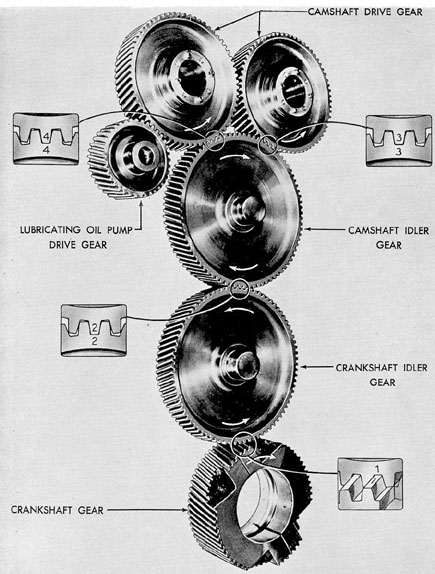 Figure 3-30. Camshaft drive gears, GM. |
| 57 |
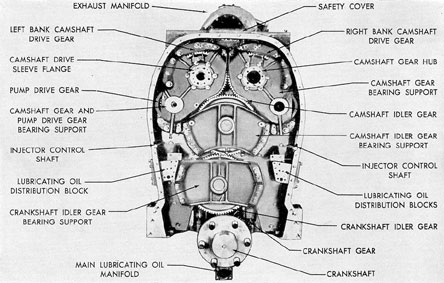 Figure 3-31. Camshaft drive assembly, GM. |
| crankshaft gear, receive lubricating oil through tubes and drilled holes in the outer bearing supports. The inner bearings are lubricated with oil that is received from the outer bearings, through holes drilled in the gear hubs.
The gear train is enclosed in an oiltight housing. The housing is accurately located on the end of the crankcase with dowel pins and is held in place with studs, some of which secure both the housing and the gear assemblies. A pressure relief opening in the top of the housing is fitted with a spring-loaded plate. g. Accessory drive. The accessory drive is located on the blower end of the engine and consists of a train of helical gears transmitting the rotation of the crankshaft to the blower and water pumps. The gears are enclosed in a case bolted to the blower housing. The blower and accessory drive gear, which drives the water pump idler gears and the blower drive gear, is driven from the crankshaft through a splined shaft, one end of which fits into a hub that is bolted to the crankshaft, while the other end fits into the blower drive gear hub. The water pump drive gears are driven by |
||
| 58 |
||
 Figure 3-33. Accessory drive assembly with cover, GM. |
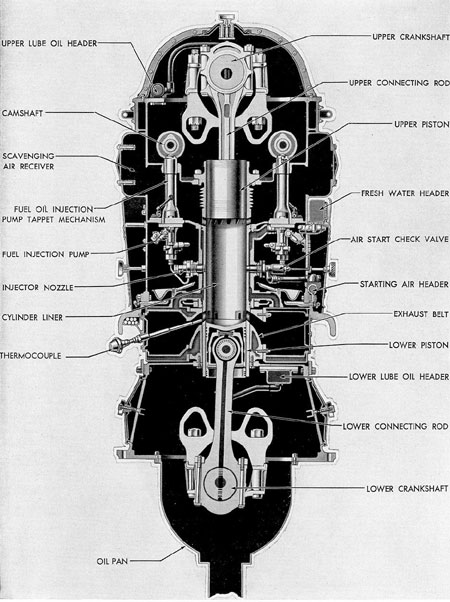 Figure 3-34. Cross section of F-M 38D 8 1/8 engine. |
| 60 |
 Figure 3-35. Cylinder block, F-M. |
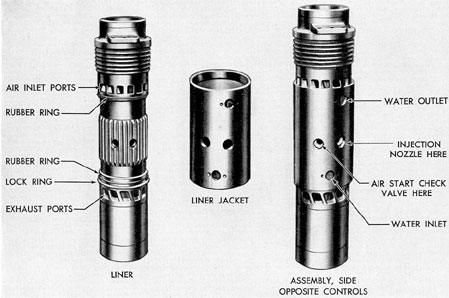 Figure 3-38. Cylinder liner, F-M. |
| 62 |
||
| The complete cylinder consists of an inner cast iron liner fitted into a steel jacket. The jacket extends over the high-pressure, high temperature part of the liner and helps to reinforce the area of greatest stress. Between the inner liner and the jacket is a space for cooling water. Cooling water enters through an elbow connection near the bottom on each side of the steel jacket and leaves through a pipe connection near the top of the steel jacket. The upper and lower circumferences of the water cooling passage between the liner and the jacket and the pipe connections at the inlet elbows of the liner are made watertight with synthetic rubber seal rings. A lock ring is also installed to position the steel jacket over the liner and prevent any movement between the liner and jacket due to expansion from the heat of engine operation.
The tangentially shaped scavenging air inlet ports are located near the top of the liner and are opened and closed by the upper piston. The exhaust ports are located near the bottom of the liner and are opened and closed by the lower piston. Each cylinder liner has four valve ports bored near its center for two injection nozzles, an air start check valve, and a cylinder relief valve with indicator cock which are adapted together. Circular ribs or radiating fins are provided near the top of the liner to allow the scavenging air to carry away some of the heat of combustion. Vertical ribs in the liner between the inlet and exhaust ports direct the water travel upward, absorbing heat from this part of the cylinder. The liner is bolted to the top deck of the cylinder block by means of lugs. The liner is held rigid at this point and any expansion of the liner due to the heat of combustion is downward through the counterbores of the engine framing and exhaust belts. Tapped holes for lifting eyebolts are also provided in the lugs that bolt the liner to the cylinder block. 3D3. Main moving parts, Fairbanks-Morse. a. Crankshafts. Each Fairbanks-Morse engine has an upper and a lower crankshaft. The upper pistons are connected to the upper crankshaft and the lower pistons are connected to the lower crankshaft. Both crankshafts are of the integral type, constructed of machined, fine grain cast |
iron, dynamically balanced. The lower crankshaft is connected to the generator by means of the crankshaft flexible coupling. The upper crankshaft is connected to the lower crankshaft by a vertical drive shaft assembly and bevel gears. As the lower crankshaft leads the upper crankshaft by about 12 degrees, it is found that the lower cylinders develop about 72 percent of the power at rated load and the upper cylinders about 28 percent of the power. As the upper crankshaft also drives the scavenging air blower and other auxiliaries, a relatively small percentage of the total power is transmitted from the upper crankshaft through the vertical drive shaft to the lower crankshaft.
Both crankshafts on the 10-cylinder engine have ten cranks. The 9-cylinder engine has two crankshafts, each having nine cranks. Main bearing and connecting rod journals are stone ground to a smooth finish. Weight and bearing loads are reduced by hollow casting the shaft and crankpins. Oil passages are drilled so as to permit lubricating oil to be forced from each main bearing journal to the adjacent crankpin journals. The crankshaft sprocket for the timing chain drive is keyed to the upper crankshaft at its control end. The air start distributor camshaft is also fastened to the upper crankshaft at the control end. At the opposite or blower end, the blower flexible drive gear is keyed and held with a retainer plate to the crankshaft. The torsional damper is keyed to the control end of the lower crankshaft and secured by means of a key and a damper hub nut. The flexible pump drive gear for driving the governor and attached pumps is keyed to the torsional damper spider. The flexible crankshaft coupling driving gear is bolted to a flange on the blower end of the lower crankshaft. b. Main bearings. Main bearings in the upper and lower crankcase support the upper and lower crankshafts. Each main bearing consists of an upper and lower precision made bearing shell that is lined with Satco metal. The upper and lower shells fit into the enclosures formed by the saddles or bearing seats in the cylinder block and the bearing caps. The bearing caps are made of forged steel. They are assembled with the bearing saddles in the cylinder |
|
| 63 |
||
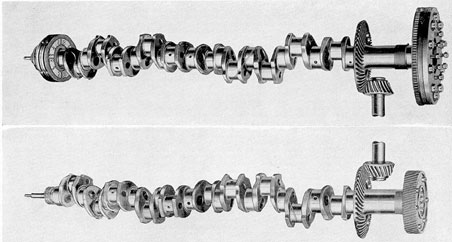 Figure 3-39. Upper and lower crankshafts, F-M. |
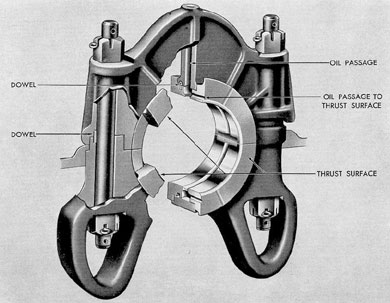 Figure 3-40. Upper crankshaft thrust bearing, F-M. |
| 64 |
||
| block and bored in line to give precision alignment and close fit to the bearing shells. Both bearing caps and saddles are finished for a close fit and form the bearing seats of the bearing shells. The bearing caps are located in the cylinder block by dowels and held by two bolts with castle nuts and cotter pins on each end. The locating dowels also prevent side and end play in the bearing cap. The upper and lower bearing shells are doweled together and marked for proper location on the edge toward the control end of the engine. The bearing shells housed in the bearing caps have dowel pins that prevent the bearing shells from rotating.
Both upper and lower bearing shells have oil grooves around the center of the inside surface. The bearings are lubricated by oil under pressure from the engine pressure system. The oil is piped to the bearing caps through lines from the main oil header and fed through holes into the grooves where it lubricates the bearing surface. Oil is conducted through oil passages in the crankshaft to the connecting rod journals and bearings. Crankshaft thrust is taken by a |
thrust bearing located at the blower end of each crankshaft. The bearing shells of the thrust bearings are similar to the regular main bearing shells except that they have enlarged flanges with bearing metal extending over the flanges to take the thrust. Slots and a drilled passage conduct oil to the thrust surfaces.
c. Torsional damper. Every crankshaft with attached rotating parts has a natural period of torsional vibration, the frequency of which depends upon the mass and elasticity of the shaft and of the parts attached to it. If turning impulses are applied to the shaft at regular intervals, and if their frequency of application is a multiple of the natural frequency of the shaft, a condition of synchronous torsional vibration is produced. This condition is not usually found in the F-M 9-cylinder engine but is definitely present in the F-M 10-cylinder engine. The points at which it occurs are known as the critical speeds. If the engine is to be permitted to run at one or more of these critical speeds, a means of damping the torsional vibration is advisable. |
|
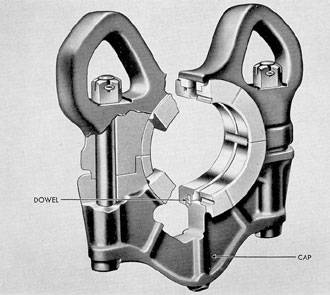 Figure 3-41. Lower crankshaft thrust bearing, F-M. |
| 65 |
||
| Otherwise the amplitude of the vibration may become great enough to cause breakage of the crankshaft.
The torsional damper is mounted on the lower crankshaft at the control end of the F-M 10-cylinder engine. This unit consists of a spider fitted with eight damper weights. These are installed in two rows in slots in the spider. Each weight is located and free to move in or out on the two weight pins, according to the speed of rotation of the crankshaft. Lubrication is furnished to the moving parts of the damper from the engine pressure system by means of grooves and holes in the spider hub. In addition to the torsional damper, it is necessary to devise a method of preventing torsional vibrations between the crankshafts and the various auxiliary drives. This is usually done by means of flexible drive gears in each auxiliary gear train and by a flexible spring coupling in the vertical drive shaft. d. Pistons and piston rings. The upper and lower pistons of the F-M diesel engines are |
similar, but are not interchangeable because of the position of the injector nozzle grooves in the piston crown. The pistons are made of closely grained cast iron and are tin plated. Each piston has four compression piston rings near the crown end. One oil control ring and two oil drain rings are located near the piston skirt. The oil control ring controls lubrication of the cylinder wall, and the oil drain rings prevent excessive lubrication of the cylinder wall. The amount of oil on the cylinder walls is also controlled by a row of small, drilled holes at the skirt end of the piston. These holes allow the lubricating oil to escape and drain to the crankcase through the piston wall after the piston rings have scraped it off the liner. They also prevent excessive pressure being built up behind the oil rings, thereby cutting down the amount of ring wear. The piston pin fits into a cast steel piston pin bracket which is in turn bolted to the main piston. The pistons are cooled by oil under pressure from the engine lubricating system. The oil is forced into the oil cooling chambers under | |
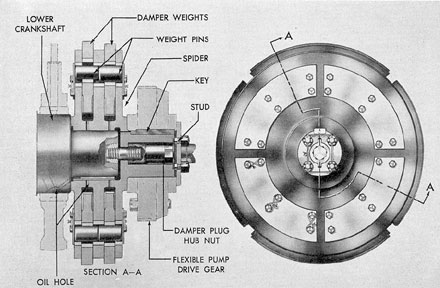 Figure 3-42. Torsional damper, F-M. |
| 66 |
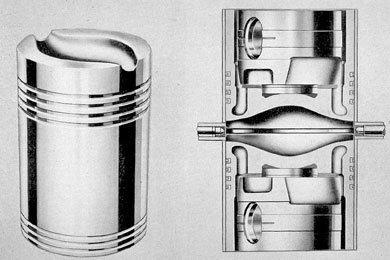 Figure 3-43. Pistons, F-M. |
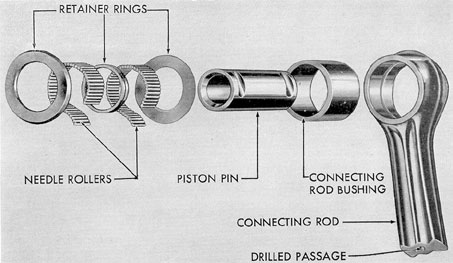 Figure 3-45. Needle roller type piston pin assembly, F-M. |
| 68 |
||
| seats. Oil is forced under pressure through holes in the bearing shell to the grooves on the inner surface of the bearing shell and to the oil passage in the connecting rod shaft. Bearing shells are marked on the outside of one flange with the number of the connecting rod. Shells should be installed with the markings placed toward the control end of the engine.
g. Vertical drive. On Fairbanks-Morse |
opposed piston engines the upper and lower crankshafts are connected at the blower end of the engine by a flexible, vertical drive shaft (Figure 3-48). A portion of the power of the upper crankshaft is expended in driving accessories and in driving the blower. The remaining power of the upper crankshaft is delivered through the vertical drive shaft to the lower crankshaft of the engine. Gears and bearings on | |
 Figure 3-46. Connecting rod with needle roller type piston pin bearing, F-M. |
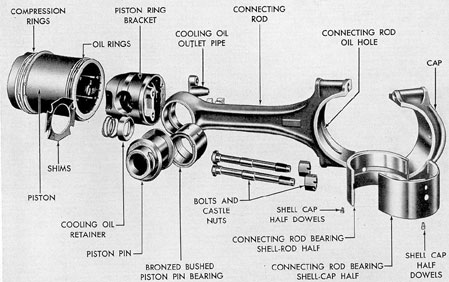 Figure 3-47. Connecting rod and piston assembly, F-M. |
| 69 |
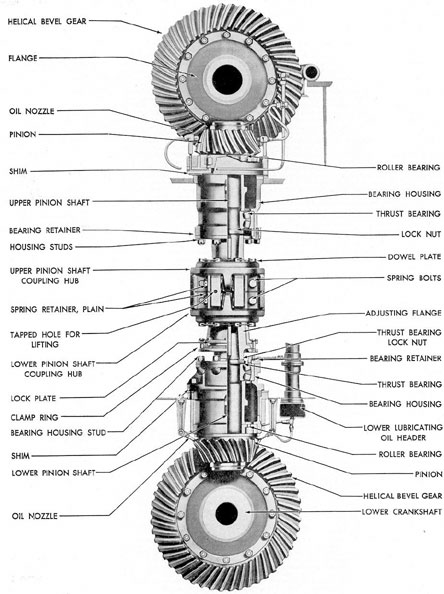 Figure 3-48. Assembled view of crankshaft vertical drive on 10-cylinder F-M engine. |
| 70 |
||
| the vertical drive shaft are lubricated directly from the main engine lubricating systems through tubes leading from the riser duct connecting the upper oil header to the lower oil header.
The 9- and 10-cylinder engine vertical drives differ in construction. In the 10-cylinder engines, helical bevel gears or ring gears are bolted to flanges on both the upper and the lower crankshafts. Each of the ring gears meshes with a helical bevel pinion. Each of the pinions is fitted and keyed to a vertical pinion drive shaft. The two pinion shafts rotate in roller and thrust bearings located in the upper and lower drive housings. These housings are bolted to the horizontal decks of the cylinder block. The inner ends of the pinion drive shafts are keyed to coupling hubs. The upper and lower pinion shaft coupling hubs are connected together by means of a flexible coil spring coupling unit having an upper and lower coupling hub and an adjusting flange, or cone coupling as it is sometimes called. The upper pinion shaft coupling hub bolts directly to the flexible spring coupling upper hub. The lower pinion shaft coupling hub is connected to the lower flexible spring coupling hub through the adjusting flange. Thus the upper and lower pinion shafts are connected by a spring-loaded flexible coupling which consists of upper and lower members between which are housed 16 coil springs held by retainers. Torque on the upper hub of the flexible coupling is passed to the coil springs which in turn apply torque to the lower hub of the flexible coupling. Thus the coupling has torsional flexibility which permits it to absorb crankshaft torsional vibrations. The flexible spring coupling also has a certain amount of vertical flexibility to allow for expansion due to operating temperatures. It has sufficient flexibility to account for a small amount of misalignment between the upper and lower pinion shafts. The adjusting flange serves as a means of disconnecting the vertical drive so that the crankshafts may be turned separately for servicing. It is clamped to a tight fit over the tapered lower pinion shaft coupling hub by means of a clamp ring and retains a fixed relation between |
shafts by means of intermediate lock plates and friction between the two cone, or tapered, surfaces. It permits an unlimited adjustment of timing to achieve an exact 12-degree crank lead of the lower crankshaft. Timing of the crankshafts for the 12-degree lead of the lower crankshaft is achieved by setting the crankshafts before clamping, then locking the clamp ring and installing the lock plates.
The 9-cylinder Fairbanks-Morse vertical drive and the 10-cylinder vertical drive use a flexible coupling, which consists of a coupling shaft with upper and lower collar, and which has a set of laminated saw steel rings at each end. Each laminated group consists of 30 to 40 rings, each .019 inch thick. The set, when installed and compressed, is about 5/8 inch thick. The upper pinion shaft coupling hub and the upper collar of the coupling shaft are bolted to the laminated rings at different points. The lower collar of the coupling shaft and the upper collar of the adjusting flange are bolted to the lower set of laminated rings at different points. The vertical flexibility of the coupling through the laminated rings allows variations due to expansion of the engine. In addition some of the Fairbanks-Morse 10-cylinder engines use a coil spring type of flexible coupling. h. Flexible drive far auxiliaries. The fresh water and sea water circulating pumps, the attached fuel oil and lube oil pumps, and the Woodward governor are all driven from the lower crankshaft through a flexible gear drive at the control end. In this drive, power is transmitted through springs which absorb shocks inherent in the engine and transmitted by the lower crankshaft. The two circulating water pumps are driven directly from the flexible gear through their driven gears. The fuel oil pump drive gear and idler gear in turn rotate the fuel oil pump driven gear. The lubricating oil pump driven, gear and drive shaft drive the pump by means of a coupling meshing with slots in the end of the shaft. A bevel gear, mounted on the lubricating oil pump drive shaft, meshing with a mating gear on the governor drive shaft, drives the governor through the governor coupling shaft The ball bearings and gears of the governor drive are lubricated with oil thrown off from the |
|
| 71 |
||
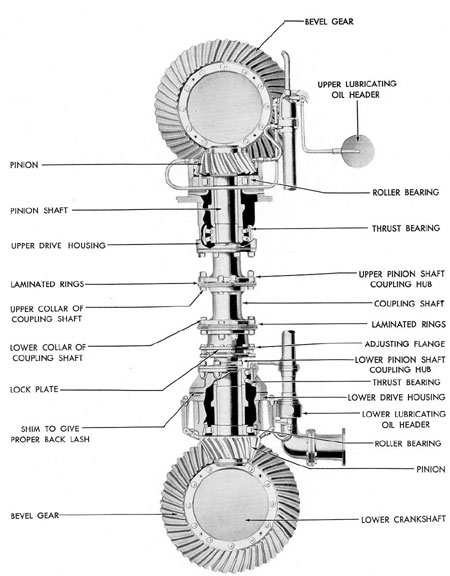 Figure 3-49. Assembled view of crankshaft vertical drive on 9-cylinder F-M engine. |
| 72 |
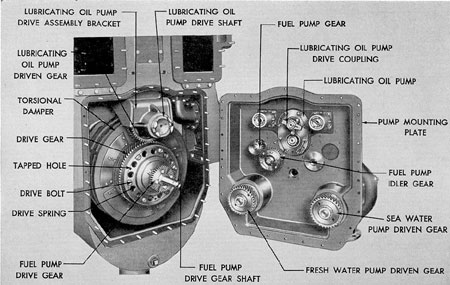 Figure 3-50. Flexible drive with housing cover removed, F-M. |
 Figure 3-51. Camshaft cross section showing control end of both camshafts, F-M. |
| 73 |
||
| timing chain in the control end compartment. The flexible drive is lubricated by oil forced through the crankshaft to the flexible drive gear, oil dropping from the Woodward governor drive | shafting, and returning oil from the upper crankcase.
3D4. Valves and valve actuating gear. a. Camshaft. The Fairbanks-Morse engine has two camshafts which are located in the upper crankshaft compartment. The function of the camshafts is to actuate the two fuel injection pumps at each cylinder in exact unison and at the proper time. Both camshafts are made of steel and each consists of three or four sections flanged and bolted together. The cams are forged integral with the camshaft and then ground to a master camshaft. The sections are match-marked so that they may be connected in proper relationship to each other. The camshafts may be removed a section at a time or in one unit. There is one cam for each cylinder on each camshaft. Each camshaft is operated by a sprocket bolted to a flange on the control end of the camshaft. Both camshaft sprockets are driven by one timing chain so that proper timing between the two camshafts is maintained. |
|
 Figure 3-53. Timing chain, F-M. |
| 74 |
||
| Each camshaft operates in bearings located at each vertical member or crosswebbing of the cylinder block. Camshaft thrust is taken by a thrust bearing located at the blower end of the camshaft. The camshaft bearings are of the split sleeve type, the upper and lower shells consisting of steel backs with soft metal or babbitt linings. The bearings are located and held in place by setscrews. The two halves are held together by snap rings.
The camshaft bearings are lubricated by oil from the upper lubricating oil header. The oil is led through oil tubes to the control end bearing of each camshaft. Oil enters the bearing cap, is forced through a hole in the bearing shell and camshaft journal to the hollow bore of the camshaft. It is then forced through radial drilled holes to each of the bearings along the entire camshaft. Oil holes in the hubs at the driving ends of the camshafts connected with the holes in the camshaft sprockets provide oil for the timing chain. The overspeed governor is mounted at the control end of the left-hand camshaft in the left-hand rotation engines and on the right-hand camshaft in right-hand rotation engines. |
b. Camshaft drive. Both camshafts are driven by one endless type timing chain connecting the crankshaft sprocket with the camshaft drive sprockets. The crankshaft sprocket is attached to the upper crankshaft at the control end of the engine. The camshaft sprocket is attached to the end of each camshaft.
The endless timing chain passes over the crankshaft sprocket, under two opposed timing sprockets, over the two camshaft drive sprockets, and under a chain tightener sprocket. The two timing sprockets are mounted on a timing bracket. The timing bracket has an 8-degree pitch adjustment. Moving the timing bracket arm moves both timing sprockets on the chain at once, changing the camshaft relation to the crankshaft. Thus the chain is tightened in operation between the crankshaft sprocket and one camshaft drive sprocket, and given more slack between the crankshaft sprocket and the other camshaft drive sprocket. This provides a precision adjustment for securing the exact phase relation desired between the crankshaft and two camshafts. The tightener sprocket is adjustable to secure the proper slack in the chain. The timing chain is assembled as shown in Figure 3-53. The guide links for guiding the chain on the timing sprockets and tightener sprocket ride in slots in the crankshaft and camshaft drive sprockets. c. Cylinder relief and indicator valves. Each cylinder in the engine is fitted with a water-cooled, automatic relief valve for the out let of excessive pressures in the combustion space. The relief valves are normally set to open at about 2,000 psi, and to close as soon as the pressure has dropped below this setting. The relief valve is threaded into the adapter valve which also has a tapped opening for an indicator valve. The complete assembly is attached to a cylinder liner valve adapter sleeve by means of a threaded collar and stud nuts. The relief and indicator valve adapter sleeve is cooled by water which is admitted to the adapter water jacket through a groove machined on the outside of the cylinder liner. The indicator valves are threaded and screwed permanently into the cylinder relief valve adapters. When a pressure reading is to be |
|
| 75 |
||
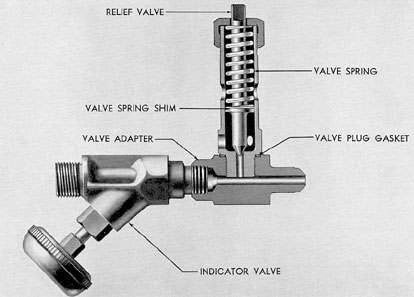 Figure 3-56. Cylinder relief valve, F-M. |
| MAIN ENGINES | AUXILIARY ENGINE |
||
| Model number | 16-278A | 16-248 | 8-268 |
| Number of cylinders | 16 | 16 | 8 |
| Bore and stroke | 8 3/4 x 10 1/2 | 8 1/2 x 10 1/2 | 6 3/8 x 7 |
| Brake horsepower (continuous) | 1600 | 1600 | 437 |
| Generator output | 1134 kw | 1134 kw | 300 kw |
| Rated engine speed | 750 rpm | 756 rpm | 1200 rpm |
| BMEP (continuous) | 83.6 psi | 88.6 psi | 80.7 psi |
| Type of engine | 2 cycle | 2 cycle | 2 cycle |
| Cylinder arrangement | 40 degrees "V" | 40 degrees "V" | In line |
| Cylinder firing order for left-hand rotation | 1-9-8-16-2-10- 6-14-4-12-5- 13-3-11-7-15 |
1-9-8-16-2-10- 6-14-4-12-5- 13-3-11-7-15 |
1-6-5-2- 8-3-4-7 |
| Cylinder firing order or right-hand rotation | 1-15-7-11-3- 13-5-12-4-14- 6-10-2-16-8-9 |
1-15-7-11-3- 13-5-12-4-14- 6-10-2-16-8-9 |
|
| Starting system | Air | Air | Air |
| Injection system | Mechanical | Mechanical | Mechanical |
| Scavenging | Uniflow | Uniflow | Uniflow |
Operating Pressures of Full Load and Speed |
|||
| Lub. oil-cooler to engine | 40-50 psi | 50 psi | 35-45 psi |
| Fuel oil to injectors | 40-50 psi | 35 psi | 50-60 psi |
| Sea water-pump to coolers | 15-35 psi | 34 psi | 10-40 psi |
| Fresh water-pump to engine | 18-35 psi | 31 psi | 15-28 psi |
| Starting air pressure to engine | 500 psi | 500 psi | 500 psi |
Operating Temperatures at Full Load and Speed |
|||
| Max. exhaust at 3" Hg. back pressure | 550-650 degrees F | 670 degrees F | 650 degrees-750 degrees F |
| Lubricating oil-engine to cooler | |||
| Range | 140-180 degrees F | 138 degrees-147 degrees F | 140 degrees-180 degrees F |
| Preferred | 170 degrees | F 145 degrees F | 170 degrees F |
| Lubricating oil-from cooler | 130-160 degrees F | 114 degrees-119 degrees F | 120 degrees-155 degrees F |
| Fresh water-engine to cooler | |||
| Range | 140 degrees-170 degrees F | 150 degrees-154 degrees F | 140 degrees-180 degrees F |
| Preferred | 160 degrees F | 160 degrees F | 160 degrees F |
| Fresh water-from cooler | 105 degrees-130 degrees F | 130 degrees-134 degrees F | 115 degrees-135 degrees F |
| Sea water temperature rise through fresh water cooler | 10-20 degrees F | 17-19 degrees F | 10-25 degrees F |
Pressure Relief Valve Settings |
|||
| Lubricating oil regulating | |||
| At full load and speed | 40-50 psi | ||
| At 375 rpm - no load | 8-12 psi | ||
| Lubricating oil at engine | 50 psi | 50 psi | 35-45 psi |
| Fuel oil to injectors | 40-50 psi | 35 psi | 50-60 psi |
Miscellaneous |
|||
| Overspeed trip setting | 802 rpm | 805 rpm | 1350 rpm |
| Torque limits for bolts, studs-ft lb | |||
| Cylinder head studs | 650 | 325 | |
| Connecting rod bolts | 100 | 70 | |
| Main bearing bolts | 550 | 300 | |
| Cylinder liner studs | 175 | ||
| 78 |
| Clearances of General Motors Principal Parts (in Inches)
|
||||
| Main Bearing | Model 278A |
Model 248 |
Model 268A |
Model 268 |
| Shell to Shaft Clearance (New) | .006-.009 | .006-.009 | .0035-.0065 | .0035-.0065 |
| Shell to Shaft Clearance-Max. Allowable (Worn) | .030 | .030 | .020 | .020 |
| Min. Allowable Shell Thickness (Worn) | .3601 | .360 | .240 | .240 |
| Thrust Bearing End Clearance-New | .030-.035 .118-.125 |
.030-.035 | .010-.013 | .010-.013 |
| Thrust Bearing End Clearance-Max. Allowable (Worn) | 31 | .050 | .025 | .025 |
Connecting Rod |
||||
| Shell to Shaft Clearance-New | .0065-.0085 | .0065-.0085 | .0025-.0065 | .0025-.0065 |
| Shell to Shaft Clearance-Max. Allowable (Worn) | .025 | .025 | .010 | .010 |
| Min. Allowable Shell Thickness (Worn) | .2381 | .2381 | .180 | .180 |
| Min. Allowable Piston Pin Dia. (Worn) | 2.992 | 2.99266 | 2.620 | 2.620 |
| Min. Allowable Piston Pin Bushing-Outer Dia. (Worn) | 3.864 | 3.86466 | Shrink fit | Shrink fit |
| Max. Allowable Piston Pin Bushing-Inner Dia. (Worn) | 3.012 | 3.01266 | 2.637 | 2.637 |
| Clearance-Piston Pin to Conn. Rod Bushing New) | .0025-.0045 | .0025-.004566 | .004-.0057 .0022-.00378 |
.004-.0057 .0022-.00378 |
| Max. Allowable Piston Pin to Conn. Rod Bushing Clearance (Worn) | .015 | .01566 | .010 | .010 |
Piston and Liner |
||||
| Piston to Liner Clearance-New | .0525-.05552 .0275-.03053 .0155-.01854 |
.0485-.05152 .0235-.02653 .0115-.01454 |
.0365-.03952 .0095-.01259 .0075-.01054 |
.0365-.03952}66 .0185-.02159}66 .0065-.00954}66 |
| Max. Allowable Piston to Liner Clearance (Worn) | .0802 .0553 |
.0752 .0503 .0404 |
.0552 .0309 .0304 |
.0552 .0309 .0304 |
| Min. Allowable Piston Dia. (Worn) | 8.7204 | 8.4754 | 6.4804 | 6.3554 |
| Max. Allowable Liner Dia. (Worn) | 8.775 | 8.525 | 6.520 | 6.395 |
| Max. Allowable Liner Out of Roundness (Worn) | .007 | .007 | .005 | .005 |
| Max. Piston Pin Bushing Dia. (Worn) | 3.008 | 3.008 | 2.632 | 2.632 |
| Piston Pin to Piston Bushing Clearance-New | .0005-.0025 | .0005-.0025 | .0007-.0022 | 0007-.0022 |
| Piston Pin to Piston Bushing Clearance-Max. Allowable (Worn) | .016 | .016 | .012 | .012 |
Piston Rings19 |
||||
| Compression-Gap Clearance (New) | .030-.050 | .030-.050 | .025-.040 | .025-.040 |
| Oil Control-Gap Clearance (New) | .030-.050 | .030-.050 | .026-.041 | .026-.041 |
| Compression-Gap Clearance-Max. Worn | .100 | .100 | .100 | .100 |
| Oil Control-Gap Clearance-Max. Worn | .100 | .100 | .100 | .100 |
| Compression-Side Clearance (New) | .008-.01056 .004-.00656 |
.008-.01055 .004-.00656 |
.0075-.01005 .0045-.007012 |
.0030-.005566 |
| Oil Control-Side Clearance (New) | .002-.0045 | .002-.0045 | .0025-.0055 | .0020-.0045 |
| Compression-Side Clearance-Max. (Worn) | .020 | .020 | .012 | .012 |
| Oil Control-Side Clearance-Max. (Worn) | .020 | .020 | .012 | .012 |
Camshaft |
||||
| Min. Shell Thickness (Worn) | .117 | .180 | .092 | .092 |
| Clearance Shell to Shaft-(New) | .0035-.0061 | .0025-.0045 | .0025-.0055 | .0025-.0055 |
| Max. Allowable Shell to Shaft Clearance (Worn) | .010 | .010 | .010 | .010 |
Valves |
||||
| Exhaust Valve Tappet Clearance (Cold) | .015 | .01565 | .018 | .018 |
| Exhaust Valve Guide to Valve Stem Clearance-New | .002-.004 | .002-.004 | .003-.005 | .003-.005 |
| Max. Allowable Exhaust Valve Guide to Valve Stem Clearance (Worn) | .012 | .012 | .010 | .010 |
Miscellaneous |
||||
| Injection Nozzle Opening Pressure | 100067 320068 |
3200 | 100067 320068 |
100067 320068 |
| Injector Tappet Clearance | ||||
| Injector Timing (BTC) | 7 degrees32 | 7 degrees32 | 12 degrees32 | 12 degrees32 |
| Lube Oil Recommended-Navy Symbol (First Choice Substitute in Paren.) | 9370-(9250) | 9370-(9250) | 9370-(9250) | 9370-(9250) |
| 1 For Satco shells only-replace Tri-metal bearings when intermediate bronze lining starts to show through | 8 Bushing with two radial holes |
| 2 At top of piston | 9 Bottom of taper below fourth ring groove |
| 3 Between fourth and fifth ring grooves | 31 Replace when backing begins to show through bearing metal |
| 4 At skirt | 32 Position of flywheel for checking injector with injector timing tool |
| 5 First and second rings from top | 66 Engines with C. I. pistons |
| 6 Third, fourth, and fifth rings from top | 67 Spherical check valve type |
| 7 Bushing with six radial holes | 68 Needle valve type |
| 79 |
| FAIRBANKS-MORSE ENGINE DATA, RATINGS, AND CLEARANCES |
|||
| MAIN ENGINES | AUXILIARY ENGINE |
||
| Model number | 38D 8 1/8 | 38D 8 1/8 | 38E 5 1/4 |
| Number of cylinders | 10 | 9 | 7 |
| Bore and stroke | 8 1/8 x 10 | 8 1/8 x 10 | 5 1/4 x 7 1/4 |
| Brake horsepower | |||
| Emergency | 1600 hp @ 720 rpm | 1600 hp @ 720 rpm | |
| Continuous | 1280 hp @ 650 rpm | 1280 hp @ 650 rpm | |
| Generator output - | |||
| Emergency | 1120 kw @ 720 rpm | 1120 kw @ 720 rpm | 300 kw |
| Continuous | 900 kw @ 650 rpm | 900 kw @ 650 rpm | |
| Rated engine speed | - | - | 1200 rpm |
| BMEP (continuous) | 84 psi | 94.3 psi | 64.3 psi |
| Type of engine | 2 cycle | 2 cycle | 2 cycle |
| Cylinder arrangement | Opposed | Opposed | Opposed |
| Cylinder firing order for left-hand rotation | 1-8-7-3-5-9-4-2-10-6 | 1-9-2-7-4-5-6-3-8 | 1-7-2-5-4-3-6 |
| Cylinder firing order for right-hand rotation | 1-6-10-2-4-9-5-3-7-8 | 1-8-3-6-5-4-7-2-9 | |
| Starting system | Air | Air | Air |
| Injection system | Mechanical | Mechanical | Mechanical |
| Scavenging | Uniflow | Uniflow | Uniflow |
Operating Pressures at Full Load and Speed |
|||
| Lub. oil-cooler to engine | 50 psi | 50 psi | 40 psi |
| Fuel oil to injectors | 25 psi | 25 psi | 25 psi |
| Starting air pressure to engine | 250 psi | 250 psi | 250 psi |
Operating Temperatures at Full Load and Speed |
|||
| Maximum exhaust, individual cylinder | 770 degrees F | 770 degrees F | 590 degrees F |
| Lubricating oil-engine to cooler | |||
| Range | 140 degrees-180 degrees F | 125 degrees-190 degrees F | 140 degrees-180 degrees F |
| Preferred | 165 degrees F | 150 degrees-170 degrees | F 165 degrees F |
| Fresh water-engine to cooler | |||
| Range | 140 degrees-170 degrees F | 120 degrees-190 degrees F | 140 degrees-170 degrees F |
| Preferred | 160 degrees F | 150 degrees-170 degrees F | 160 degrees F |
Oil Pressures |
|||
| Lubricating oil-engine upper header | 17-32 psi | 17-32 psi | 21-47 psi - |
| Fuel oil to fuel injection pump | 5-20 psi | 5-20 psi | 7-21 psi |
Miscellaneous |
|||
| Overspeed trip setting | 778-835 rpm | 800 rpm | 1290-1370 rpm |
Clearances of Principal Parts (in Inches) |
|||
| Camshaft bearings | 0.0035-0.0060 | 0.0035-0.0060 | 0.0015-0.0040 |
| Connecting rod bearings | 0.0050-0.0075 | 0.0050-0.0075 | 0.0030-0.0055 |
| Main bearings | 0.0090-0.0115 | 0.0090-0.0115 | 0.0070-0.0095 |
| Main thrust bearings-width | 0.0050-0.0100 | 0.0050-0.0100 | 0.0050-0.0110 |
| Piston diameter | 0.0085-0.0135 | 0.0095-0.0125 | 0.0080-0.0100 |
| Piston rings: | |||
| Compression rings (top 2) | |||
| side clearance | 0.0080-0.0100 | 0.0080-0.0100 | 0.0090-0.0110 |
| gap clearance | 0.0300-0.0400 | 0.0300-0.0400 | 0.0200-0.0300 |
| Compression rings (3 and 4) | |||
| side clearance | 0.0050-0.0080 | 0.0050-0.0075 | 0.0070-0.0090 |
| gap clearance | 0.0300-0.0400 | 0.0300-0.0400 | 0.0200-0.0300 |
| Oil rings | |||
| oil cutter ring, side | 0.0005-0.0020 | ||
| oil cutter ring, gap | 0.0250-0.0300 | ||
| other oil rings, side | 0.0015-0.0045 | 0.0015-0.0040 | 0.0030-0.0036 |
| other oil rings, gap | 0.0150-0.0250 | 0.0150-0.0250 | 0.0150-0.0250 |
| Piston pin bearing | 0.0055-0.0065 | 0.0020-0.0034 | 0.0015-0.0029 |
| Vertical drive gears Backlash | 0.0120-0.0160 | 0.0120-0.0160 | 0.0030-0.0100 |
| 80 |

We use cookies to improve your experience. By continuing to use our site, you accept our Cookies, Privacy Policy,Terms and Conditions. Close X